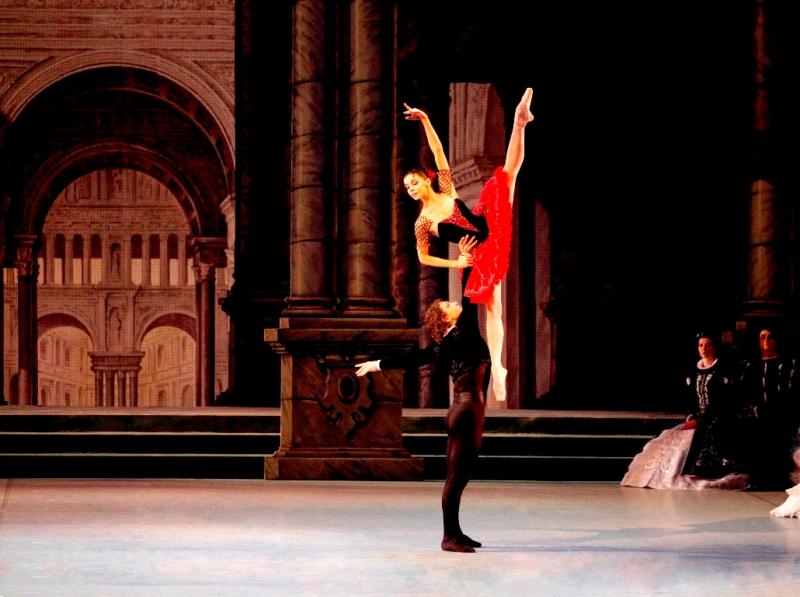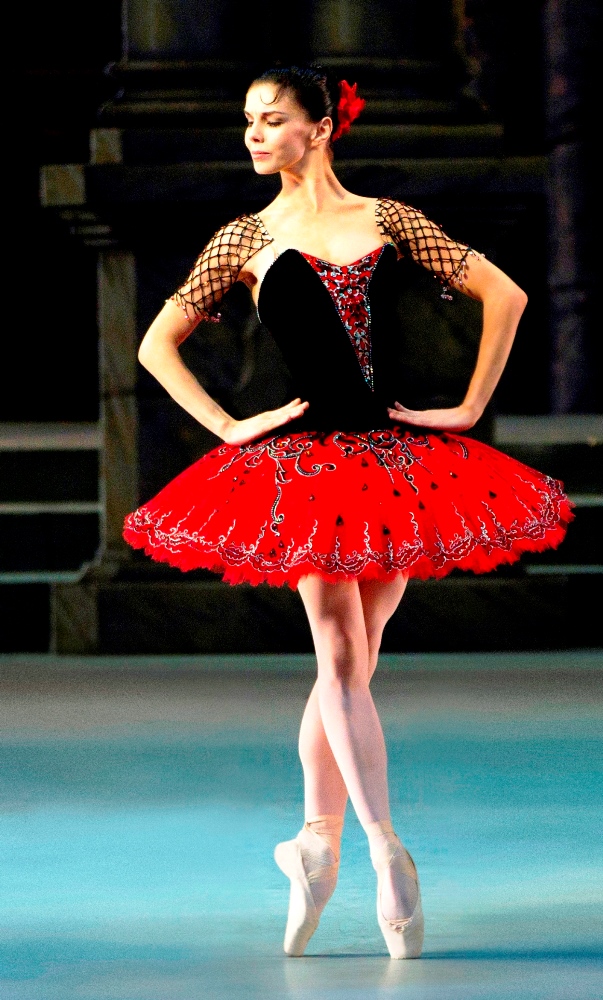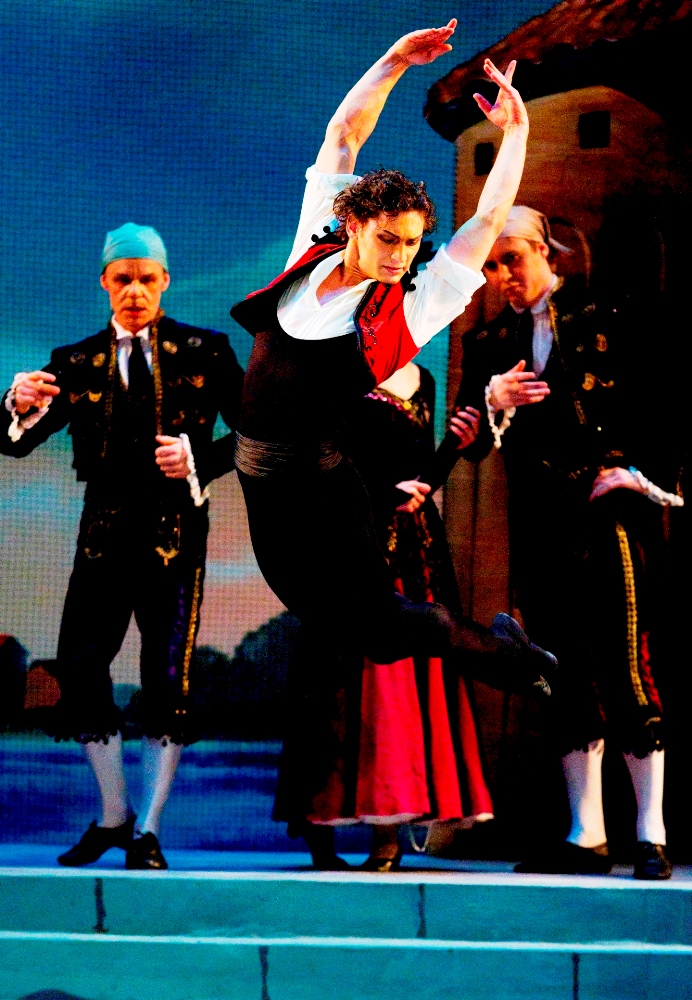Don Quixote, Mikhailovsky Ballet, London Coliseum | reviews, news & interviews
Don Quixote, Mikhailovsky Ballet, London Coliseum
Don Quixote, Mikhailovsky Ballet, London Coliseum
A perfectly paced production of a demented old warhorse

If you want virtuosity, there’s only one place to be in London right now, and that’s watching the Mikhailovsky’s fine production of that demented old warhorse, Don Quixote, with Natalia Osipova and Ivan Vasiliev in the leads.
Don Quixote is one of the 19th-century’s pastiche pleasures, half-pantomime, half-burlesque, all razzmatazz. Choreographed by a Russian (actually, over time, six Russians), set in a Spain that never was, with music by an Austro-Hungarian, the last thing the ballet is is coherent. Instead one tiny episode from the original Cervantes novel, the story of a barber and his love, is blown up to take over the evening, and every now and again, seemingly on a whim, the Don and Sancho Panza wander through.
 The famous pas de deux, often danced as a gala piece on its own, is from the last act, and is the culmination of a series of virtuosic show-stoppers, each more staggering than the next. Vasiliev’s macho little bantam-rooster of a performance makes short work of some amazing leaps; Osipova, a famous turner, brings the house down with an equally astonishing series of fouettés. But what makes them artists, rather than merely gymnasts, is that every linking section was taken equally seriously. The blistering ferocity of Vasiliev’s jetés, the dazzling light speed of Osipova’s chainé turns – the bits where they could have taken a breather, but didn’t – are what make them special.
The famous pas de deux, often danced as a gala piece on its own, is from the last act, and is the culmination of a series of virtuosic show-stoppers, each more staggering than the next. Vasiliev’s macho little bantam-rooster of a performance makes short work of some amazing leaps; Osipova, a famous turner, brings the house down with an equally astonishing series of fouettés. But what makes them artists, rather than merely gymnasts, is that every linking section was taken equally seriously. The blistering ferocity of Vasiliev’s jetés, the dazzling light speed of Osipova’s chainé turns – the bits where they could have taken a breather, but didn’t – are what make them special.
Mikhail Messerer, the company’s ballet master, is also a master of revival, and has sympathetically staged several of the classics for this company. Don Q is not easy to get right. Treat it as opera buffo without the singing, and you’ve killed the humour; concentrate too much on the dance episodes and the story fragments. Messerer has judged the tempo to perfection, allowing us a bit of a romp here, a taste of character-dancing there, and showcased the company’s superstars without allowing their virtuosity to overshadow the other company members’ very real talents.
 For equally delightful is Alexander Omar’s gypsy king, Veronica Ignatyeva’s Cupid, and, especially, Ekaterina Borchenko’s Queen of the Dryads, her long, elegant legs and beautiful line a perfect foil for the bouncy little Osipova. The company moved smoothly between the demi-charactère of the Spanish acts, the classical rigour of the vision scene, and the courtly world of the last act, no easy transitions to make. In this they were aided by Pavel Bubelnikov, the conductor and musical director, who oversaw a committed performance of what is, it must be confessed, a pretty ropey score.
For equally delightful is Alexander Omar’s gypsy king, Veronica Ignatyeva’s Cupid, and, especially, Ekaterina Borchenko’s Queen of the Dryads, her long, elegant legs and beautiful line a perfect foil for the bouncy little Osipova. The company moved smoothly between the demi-charactère of the Spanish acts, the classical rigour of the vision scene, and the courtly world of the last act, no easy transitions to make. In this they were aided by Pavel Bubelnikov, the conductor and musical director, who oversaw a committed performance of what is, it must be confessed, a pretty ropey score.
Messerer has also added some original and interesting elements, such as the children’s puppet show that mimes the story of the Don’s quest for Dulcinea, in brusque marionette tempo and silvery-white costume, an appropriately ghostly moment among the teeth, eyebrows and tambourines that flash and dazzle for the rest of the evening.
Watch Osipova in Don Quixote
Share this article
Add comment
The future of Arts Journalism
You can stop theartsdesk.com closing!
We urgently need financing to survive. Our fundraising drive has thus far raised £49,000 but we need to reach £100,000 or we will be forced to close. Please contribute here: https://gofund.me/c3f6033d
And if you can forward this information to anyone who might assist, we’d be grateful.

Subscribe to theartsdesk.com
Thank you for continuing to read our work on theartsdesk.com. For unlimited access to every article in its entirety, including our archive of more than 15,000 pieces, we're asking for £5 per month or £40 per year. We feel it's a very good deal, and hope you do too.
To take a subscription now simply click here.
And if you're looking for that extra gift for a friend or family member, why not treat them to a theartsdesk.com gift subscription?
more Dance
 'We are bowled over!' Thank you for your messages of love and support
Much-appreciated words of commendation from readers and the cultural community
'We are bowled over!' Thank you for your messages of love and support
Much-appreciated words of commendation from readers and the cultural community
 Peaky Blinders: The Redemption of Thomas Shelby, Rambert, Sadler's Wells review - exciting dancing, if you can see it
Six TV series reduced to 100 minutes' dance time doesn't quite compute
Peaky Blinders: The Redemption of Thomas Shelby, Rambert, Sadler's Wells review - exciting dancing, if you can see it
Six TV series reduced to 100 minutes' dance time doesn't quite compute
 Giselle, National Ballet of Japan review - return of a classic, refreshed and impeccably danced
First visit by Miyako Yoshida's company leaves you wanting more
Giselle, National Ballet of Japan review - return of a classic, refreshed and impeccably danced
First visit by Miyako Yoshida's company leaves you wanting more
 Quadrophenia, Sadler's Wells review - missed opportunity to give new stage life to a Who classic
The brilliant cast need a tighter score and a stronger narrative
Quadrophenia, Sadler's Wells review - missed opportunity to give new stage life to a Who classic
The brilliant cast need a tighter score and a stronger narrative
 The Midnight Bell, Sadler's Wells review - a first reprise for one of Matthew Bourne's most compelling shows to date
The after-hours lives of the sad and lonely are drawn with compassion, originality and skill
The Midnight Bell, Sadler's Wells review - a first reprise for one of Matthew Bourne's most compelling shows to date
The after-hours lives of the sad and lonely are drawn with compassion, originality and skill
 Ballet to Broadway: Wheeldon Works, Royal Ballet review - the impressive range and reach of Christopher Wheeldon's craft
The title says it: as dancemaker, as creative magnet, the man clearly works his socks off
Ballet to Broadway: Wheeldon Works, Royal Ballet review - the impressive range and reach of Christopher Wheeldon's craft
The title says it: as dancemaker, as creative magnet, the man clearly works his socks off
 The Forsythe Programme, English National Ballet review - brains, beauty and bravura
Once again the veteran choreographer and maverick William Forsythe raises ENB's game
The Forsythe Programme, English National Ballet review - brains, beauty and bravura
Once again the veteran choreographer and maverick William Forsythe raises ENB's game
 Sad Book, Hackney Empire review - What we feel, what we show, and the many ways we deal with sadness
A book about navigating grief feeds into unusual and compelling dance theatre
Sad Book, Hackney Empire review - What we feel, what we show, and the many ways we deal with sadness
A book about navigating grief feeds into unusual and compelling dance theatre
 Balanchine: Three Signature Works, Royal Ballet review - exuberant, joyful, exhilarating
A triumphant triple bill
Balanchine: Three Signature Works, Royal Ballet review - exuberant, joyful, exhilarating
A triumphant triple bill
 Romeo and Juliet, Royal Ballet review - Shakespeare without the words, with music to die for
Kenneth MacMillan's first and best-loved masterpiece turns 60
Romeo and Juliet, Royal Ballet review - Shakespeare without the words, with music to die for
Kenneth MacMillan's first and best-loved masterpiece turns 60
 Help to give theartsdesk a future!
Support our GoFundMe appeal
Help to give theartsdesk a future!
Support our GoFundMe appeal

Comments
The company need to watch
The audience experience is
The puppet show is standard
what do critics (often self
Was the queen of dyads
stage management was